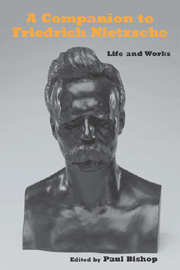Book contents
- Frontmatter
- Contents
- Acknowledgments
- A Note on Editions and Abbreviations
- Introduction
- Link to Nietzsche's Early Writings
- Link to The Birth of Tragedy
- Link to Untimely Meditations
- Link to Human, All Too Human
- Link to Daybreak
- Link to The Gay Science
- Link to Zarathustra
- Link to Beyond Good and Evil
- Link to On the Genealogy of Morals
- Link to The Case of Wagner and Nietzsche contra Wagner
- Link to Twilight of the Idols, The Anti-Christ, and Ecce Homo
- Link to the Nachlass
- Conclusion
- Notes on the Contributors
- Index
Link to Human, All Too Human
Published online by Cambridge University Press: 05 February 2013
- Frontmatter
- Contents
- Acknowledgments
- A Note on Editions and Abbreviations
- Introduction
- Link to Nietzsche's Early Writings
- Link to The Birth of Tragedy
- Link to Untimely Meditations
- Link to Human, All Too Human
- Link to Daybreak
- Link to The Gay Science
- Link to Zarathustra
- Link to Beyond Good and Evil
- Link to On the Genealogy of Morals
- Link to The Case of Wagner and Nietzsche contra Wagner
- Link to Twilight of the Idols, The Anti-Christ, and Ecce Homo
- Link to the Nachlass
- Conclusion
- Notes on the Contributors
- Index
Summary
In Leipzig Nietzsche had become friends with Heinrich Romundt (1845–1919), another classical philologist who joined the Philological Society, or Philologischer Verein, co-founded by Nietzsche. But both Nietzsche and Franz Overbeck, the theologian, were amazed by Romundt's decision in February 1875 to convert to Roman Catholicism and become a priest. Writing to Erwin Rohde on 28 February 1875, Nietzsche described Romundt as “a domestic problem, a house ghost” (ein Hausleiden, ein Hausgespenst), and expressed his indignation at Romundt's decision in a way that might surprise us: “Our good, pure, Protestant air! I have never felt my innermost dependence on the spirit of Luther more strongly than now, and this unfortunate fellow wants to turn his back on all these liberating spirits?” (Unsre gute reine protestantische Luft! Ich habe nie bis jetzt stärker meine innigste Abhängigkeit von dem Geiste Luther gefühlt als jetzt, und allen diesen befreienden Genien will der Unglückliche den Rücken wenden? KSB 5, 27–28).
Nietzsche's avowal of an affinity with Luther is surprising, but his attachment to the Protestant spirit is precisely because of its “liberating” (befreiend) effect. And 1875 and the following years stood very much under the sign of Nietzsche's search for liberation. First, his liberation from his sense of solitude, vividly expressed in another letter to Rohde — “we are all so solitary as we sit in our lighthouse — and if only it was just a lighthouse!” (wir sitzen alle so einsam auf unserem Leuchtturm — und wenn es nur immer ein Leuchtturm wäre! KSB 5, 6) — which explains his close friendship in 1875 with Marie Baumgartner, his proposal of marriage in spring 1876 to Mathilde Trampedach, and possibly later in 1876 to Louise Ott.
- Type
- Chapter
- Information
- A Companion to Friedrich NietzscheLife and Works, pp. 109 - 113Publisher: Boydell & BrewerPrint publication year: 2012



